This was published 4 years ago
Qantas London to Sydney non-stop: On board Project Sunrise's epic test flight
By Julietta Jameson
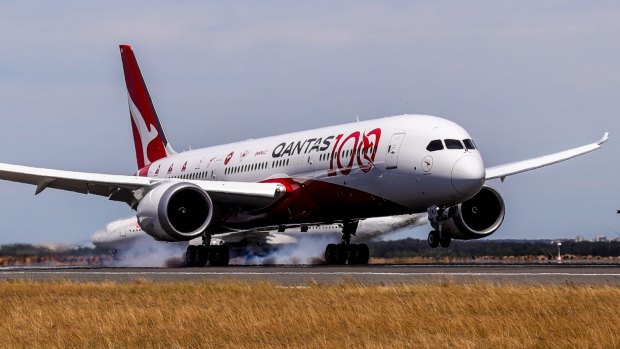
Qantas's test flight touches down in Sydney after flying non-stop from London.Credit: AP
No stopover? No problem, writes Julietta Jameson who was on the longest of long-haul flights, QF7879, Qantas's non-stop London-Sydney test flight on Thursday.
12 HOURS BEFORE
I am about to take an epic, 17,800-kilometre, 19.5-hour (or so) flight, direct from London to Sydney, without traditional stopover – and I am nervous. Before I left Australia and told people I was planning to do this, I got reactions ranging from "How exciting! Lucky you!" to "Are you mad? That is my idea of Dante's seventh ring of Hell." Derisive guffaws with a sarcastic "Good luck" was another memorable response; that one from my chiropractor.
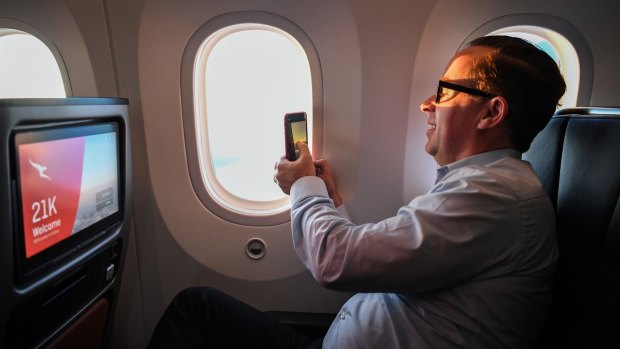
Qantas CEO Alan Joyce snaps a photo of the sunrise during the flight.
But it's not the distance and time that worries me. It's this: what if, along the way, I was to freak out, or get ill, and the plane had to land in Kazakhstan to offload me, thus, suddenly no longer being without stopover? (I have no logical reason for this fear but that's anxiety for you.)
This Qantas flight is being touted as the "last frontier" of aviation by the airline's CEO Alan Joyce, who will be onboard. A small group of Qantas Frequent Flyers are taking part in this, the second of three Project Sunrise research flights (the first, New York – Sydney non-stop was four weeks prior; the third, repeating that route, is scheduled for December). This is also the world's first passenger-carrying non-stop flight from London to Sydney (Qantas flew a 747 non-stop, without passengers, in 1989).
These re-purposed 787 Dreamliner delivery flights render the frequent flyers human guinea pigs. They are being subject to special behavioural modifications involving food, movement and sleep/light exposure. Researchers will monitor their mood and wellbeing.
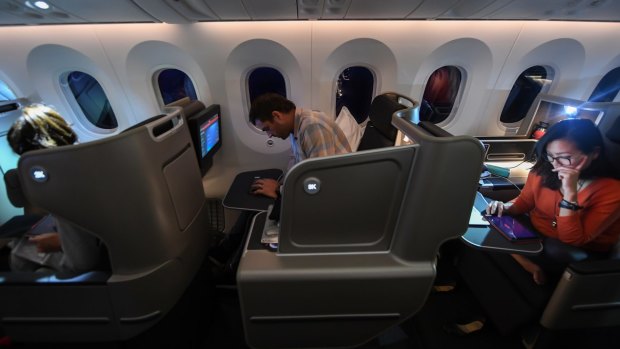
All passengers during the test flight were in business class seats.
Perhaps more importantly they also monitor flight crew with brainwave-reading headsets and urine samples to check hormones with a view to helping build a "business case" for bringing ultra-long-haul into service by 2023. The pilots' union and the Civil Aviation Safety Authority will need convincing.
2.5 – 0 HOURS BEFORE
A 2am alarm means I'm up and about with no time to think as I collect my things and leave the hotel. We arrive at the airport at 4.10am
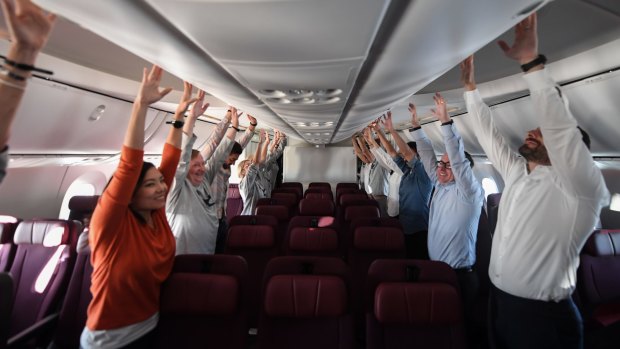
Passengers do exercises on board to help combat jet lag.
Qantas CEO Alan Joyce, the frequent flyers, researchers Qantas staff, myself and other media converge on Heathrow's Terminal 3, 52 of us in all. A further 10 crew converge also join us.
Security isn't open, but a coffee shop is and I grab a latte. I barely get three sips of my coffee in before security opens and I have to ditch it.
At the gate lounge, I have a headache. I must be hanging out for caffeine. Professor Corinne Caillaud from the University of Sydney's Charles Perkins Centre is in charge of Project Sunrise wellbeing programs and she warns me against coffee. "We'll be going to sleep soon," she says. "Okay, I'll just hydrate," I say, a little sheepishly.
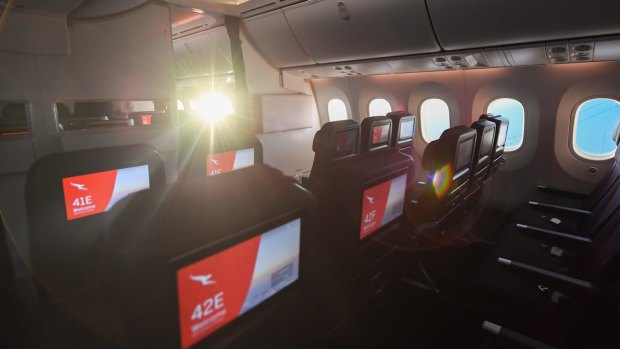
The test flights are part of Project Sunrise, so named because passengers on the ultra-long hauls will see the sunrise twice.
At 5.40am, we board. Everyone's in business class, with premium economy and economy class empty.
"How's that new-plane smell?" Mr Joyce calls with a grin as he passes my seat 7F on his way to 1A.
We push back at 5.52am and right on the hour when Heathrow's curfew lifts, 6am, we hit the runway and take off.
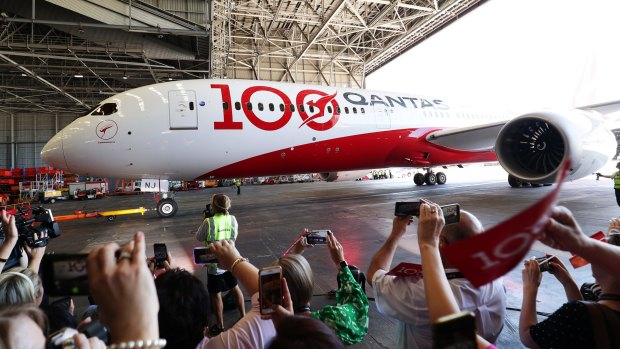
The flight arrives in Sydney where a celebration is held to mark Qantas' 100th year of service.
0-2.5 HOURS
One of the big excitements of the journey is the fact that we will see two sunrises. Project Sunrise is named to commemorate a 1943 landmark, when Qantas began a WW2 clandestine Perth–Sri Lanka service, which continued on to London with a leg operated by BOAC. The flight time was 27 hours and passengers witnessed two sunrises. It became known as the Double Sunrise service.
And now, here we are, about half an hour into our journey, seeing the first of our two sunrises, this one over Berlin. Even crew make their way to windows for a glimpse.
Jetlag is a misalignment of our circadian rhythms. The plan is to avoid confusing the body clock. So at 7am London time, we order "supper". On most long-haul flights, first meal times are anchored to the destination they've just left. As part of the Project Sunrise protocols, we've been put straight onto Sydney time. In theory, this will help mitigate jet lag. So, even though in London it's breakfast time, for us, it's Sydney's 6pm and dinner time.
The menu is designed by Qantas collaborator Neil Perry, and for this meal it is full of ingredients believed to "trick the body clock" into being ready for sleep: dairy, white bread and warming foods. Rockpool chef, Andreas Langadinos is busy onboard preparing everything.
The steak sandwich is popular, but I'm not sure red meat will help me sleep. I order the "haloumi, kale and zucchini bowl with poached egg and lemon dressing". It sounds lighter.
Half an hour later, Professor Caillaud leads passengers in exercise, an integral part of the three-pronged approach to behaviour modification. Those empty economy aisles come in handy for a few walking laps. Then there's much bending and stretching, which Alan Joyce seems to enjoy.
2.5-3.5 HOURS
Seventeen hours to go, and here comes supper. I have a glass of pinot noir with what turns out to be a delicious meal. The entree for all is a roast chicken broth with macaroni and shitaki mushrooms, the dessert a lovely vanilla rose cream with strawberries, pistachio cake and strawberry jelly. While I eat, I watch an episode of one of my favourite shows to watch on planes, the hilarious Fresh Off The Boat, but I'm still a little bit too excited to concentrate on it.
I have a chat to Alan Joyce about a number of things, including carbon emissions. There are valid concerns that ultra-long-haul can create more emissions than planes which stop over due to reduced cargo and passengers combined with more fuel. This flight is completely carbon offset. Mr Joyce reiterates the airline's commitment to zero carbon emissions by 2050.
3.5-10 HOURS
We still have 16 hours to go, and it's lights out. No doubt, this is helped by the 2am London wakeup call, but I genuinely feel ready for rest.
I still have a bit of a headache but find a Sarah Wilson podcast with some nice guided meditations on it that seems to help it dissipate. As I nod off, I note on the entertainment system's flight tracker that there are 15 hours and 26 minutes of flying time to go.
I wake on and off for the first five hours but put myself back to sleep each time with deep breathing exercises.
10-13.5 HOURS
Around 3.35am Sydney time, I wake fully and check the flight path. The aircraft is over Guangzhou, China. We've passed Kazakhstan! And I'm still onboard! But it seems a terrible time to be awake, considering the aim is to mitigate jetlag.
I put my eye mask back on, pop in the earplugs, employ my breathing strategy and I'm out again.
13.5 HOURS
Lights are on. And what do you know, there's only six and a half hours to go. I feel great. Rested and happy. This doesn't feel hard at all. We have strong macchiatos and cold pressed juice, designed to wake us up. CNN's Richard Quest passes by. He says he thinks the flight hasn't been as hard as one might have anticipated because there are so few people onboard, because there are no trolleys jostling by, no crying babies and because we've all been up and about and social. I don't disagree, but I really do think the whole "tricking the body clock" thing has worked for me.
Professor Caillaud leads another exercise session.
14 HOURS
Breaky time. I have the "breakfast bowl with cauliflower, mint, chickpeas, crisp pancetta, poached egg and harissa dressing". It's delicious and it occurs to me, I am eating more healthily during this 19 hours than I have in 19 months. I watch another episode of Fresh Off the Boat. That's only one hour of TV all up. Richard Quest has been similarly frugal in his viewing. And it's a point worth noting: we've been busy doing interviews and making observations for our coverage. Being busy makes the time go faster.
In contrast, a Qantas staffer tells me she has binged the entire season of HBO's Chernobyl. That's 350 minutes of viewing. She also says the series was far more gruelling than the flight.
15 HOURS
I pass through to economy to catch the second sunrise over Anbon, Indonesia. I'm ensconced by a window behind the wing to appreciate it.
Captain Helen Trennery makes a moving announcement about the Qantas World War 2 flights after which Project Sunrise is named. Alan Joyce swings by. "It's beautiful isn't it."
"How good is aviation!" I say, and feel a bit like an idiot. He laughs, kindly.
I spend the rest of the hour chatting to other passengers.
16 HOURS
I'm sitting up, working on my MacBook, feeling great. I chat to two of the research participants sitting across the aisle. They've been filling in diaries on their wellbeing and doing alertness tests throughout the flight. They are perhaps less perky than me and have had less sleep but are in accord that they would do the ultra-long-haul, without stopover again if they could. That would be music to Alan Joyce's ears, who hopes, all things going his way, to make that a reality by 2023.
The frequent flyers head off for a final exercise session.
17-19 HOURS
Lunch is served. I have the "chicken, farro and quinoa salad with watercress, golden beetroot and grilled leeks". Again, delicious.
Captain Helen Trennery announces that we are 1800 kilos of fuel in surplus of where we were anticipated to be. We are less than 1.5 hours out of Sydney.
I change out of my PJs and go to put my shoes on. I note some swelling in my ankles, but not huge amounts. It's the only ill effect I can sense.
Chocolate tarts are served, another part of that whole "wake me up" food strategy.
19 HOURS, 4 MINUTES
Cabin crew, prepare for landing.
19 HOURS, 19 MINUTES
We touch down in Sydney where we join the party in Hangar 96 to celebrate the beginning of the airline's centenary year.
If the way I'm feeling is the harbinger of reduced jet lag I think it is, I'll be having a little private celebration of my own.
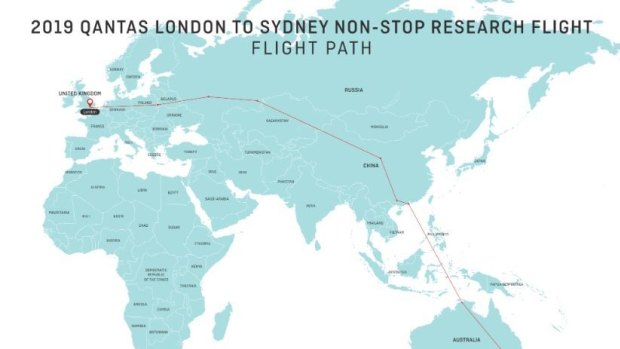
VERDICT
The whole "supper at breakfast time" approach actually worked for me. I seemed to have got onto Australian time and the food really seemed to do what it was meant to: comfort me before bed, energise me for the day. Would I fly London or New York direct to Sydney if the Project Sunrise flights achieve commercial viability and are available from 2023? Yes, absolutely. In economy? Yes, absolutely, but in an aisle seat only. I need to get up and move. I drink a lot of water on flights also, so need easy loo access. But Joyce says economy seats will be bigger and the space around them roomier in the planes that will run these services. Those will be either a version of A350 or B777.
The advantage a non-stop flight was the winner for me. The ability to get into the destination time-zone rhythm and not have that interrupted felt right.
POSTSCRIPT
Forty-eight hours later, I don't have jet lag. The only problem I had was blurred vision due to dry eyes which I solved with over-the-counter drops.
The first night post-flight, I had 10 hours sleep and woke at 8am. That's unheard of for me after coming home from Europe and/or the UK. Usually I'm to bed late, wake in the wee hours and need to sleep uncontrollably during the day. Coming back from Dublin a few weeks prior, I slept until 1pm the day after arrival. It was a disaster. I was jet lagged for two weeks.
The day after my flight I was alert and productive and that night, I went out for dinner with friends. After, I had a solid eight-hour sleep.
I did wake with a cold, though, a reminder that flying can suppress immune function and the low humidity environment in the cabin can make us more susceptible to airborne infection – no matter when we eat our meals.
Julietta Jameson travelled as a guest of Qantas.
See also: New world's longest flights: What's next for ultra long haul routes
See also: My epic trip on board the world's longest commercial flight
Sign up for the Traveller newsletter
The latest travel news, tips and inspiration delivered to your inbox. Sign up now.